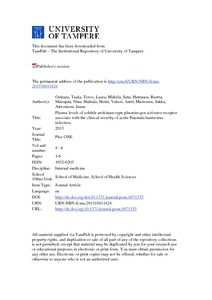Plasma levels of soluble urokinase-type plasminogen activator receptor associate with the clinical severity of acute Puumala hantavirus infection
Outinen, Tuula; Tervo, Laura; Mäkelä, Satu; Huttunen, Reetta; Mäenpää, Nina; Huhtala, Heini; Vaheri, Antti; Mustonen, Jukka; Aittoniemi, Janne (2013)
Outinen, Tuula
Tervo, Laura
Mäkelä, Satu
Huttunen, Reetta
Mäenpää, Nina
Huhtala, Heini
Vaheri, Antti
Mustonen, Jukka
Aittoniemi, Janne
2013
Plos ONE 8 8
1-6
Lääketieteen yksikkö - School of Medicine
Terveystieteiden yksikkö - School of Health Sciences
This publication is copyrighted. You may download, display and print it for Your own personal use. Commercial use is prohibited.
Julkaisun pysyvä osoite on
https://urn.fi/URN:NBN:fi:uta-201310011424
https://urn.fi/URN:NBN:fi:uta-201310011424
Kuvaus
Public Library of Science open access
Tiivistelmä
Objectives
Urokinase-type plasminogen activator receptor is a multifunctional glycoprotein, the expression of which is increased during inflammation. It is known to bind to β3-integrins, which are elementary for the cellular entry of hantaviruses. Plasma soluble form of the receptor (suPAR) levels were evaluated as a predictor of severe Puumala hantavirus (PUUV) infection and as a possible factor involved in the pathogenesis of the disease.
Design
A single-centre prospective cohort study.
Subjects and Methods
Plasma suPAR levels were measured twice during the acute phase and once during the convalescence in 97 patients with serologically confirmed acute PUUV infection using a commercial enzyme-linked immunosorbent assay (ELISA).
Results
The plasma suPAR levels were significantly higher during the acute phase compared to the control values after the hospitalization (median 8.7 ng/ml, range 4.0–18.2 ng/ml vs. median 4.7 ng/ml, range 2.4–12.2 ng/ml, P<0.001). The maximum suPAR levels correlated with several variables reflecting the severity of the disease. There was a positive correlation with maximum leukocyte count (r = 0.475, p<0.001), maximum plasma creatinine concentration (r = 0.378, p<0.001), change in weight during the hospitalization (r = 0.406, p<0.001) and the length of hospitalization (r = 0.325, p = 0.001), and an inverse correlation with minimum platelet count (r = −0.325, p = 0.001) and minimum hematocrit (r = −0.369, p<0.001).
Conclusion
Plasma suPAR values are markedly increased during acute PUUV infection and associate with the severity of the disease. The overexpression of suPAR possibly activates β3-integrin in PUUV infection, and thus might be involved in the pathogenesis of the disease.
Urokinase-type plasminogen activator receptor is a multifunctional glycoprotein, the expression of which is increased during inflammation. It is known to bind to β3-integrins, which are elementary for the cellular entry of hantaviruses. Plasma soluble form of the receptor (suPAR) levels were evaluated as a predictor of severe Puumala hantavirus (PUUV) infection and as a possible factor involved in the pathogenesis of the disease.
Design
A single-centre prospective cohort study.
Subjects and Methods
Plasma suPAR levels were measured twice during the acute phase and once during the convalescence in 97 patients with serologically confirmed acute PUUV infection using a commercial enzyme-linked immunosorbent assay (ELISA).
Results
The plasma suPAR levels were significantly higher during the acute phase compared to the control values after the hospitalization (median 8.7 ng/ml, range 4.0–18.2 ng/ml vs. median 4.7 ng/ml, range 2.4–12.2 ng/ml, P<0.001). The maximum suPAR levels correlated with several variables reflecting the severity of the disease. There was a positive correlation with maximum leukocyte count (r = 0.475, p<0.001), maximum plasma creatinine concentration (r = 0.378, p<0.001), change in weight during the hospitalization (r = 0.406, p<0.001) and the length of hospitalization (r = 0.325, p = 0.001), and an inverse correlation with minimum platelet count (r = −0.325, p = 0.001) and minimum hematocrit (r = −0.369, p<0.001).
Conclusion
Plasma suPAR values are markedly increased during acute PUUV infection and associate with the severity of the disease. The overexpression of suPAR possibly activates β3-integrin in PUUV infection, and thus might be involved in the pathogenesis of the disease.
Kokoelmat
- Artikkelit [6140]
